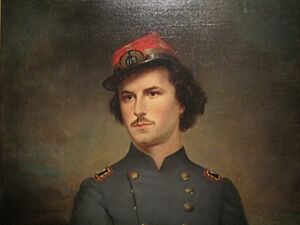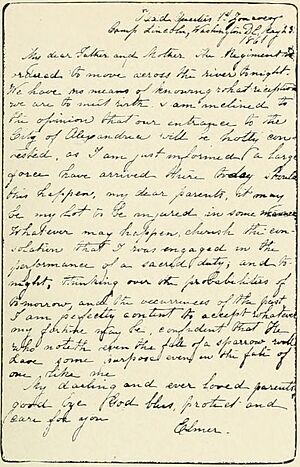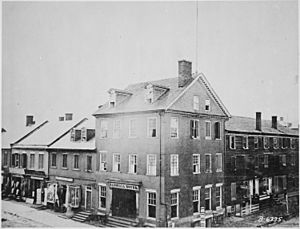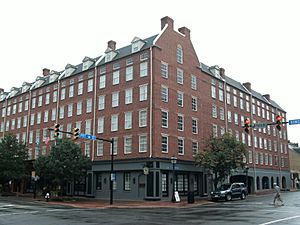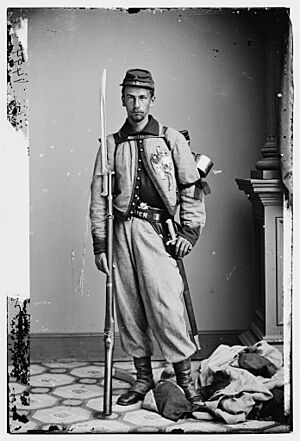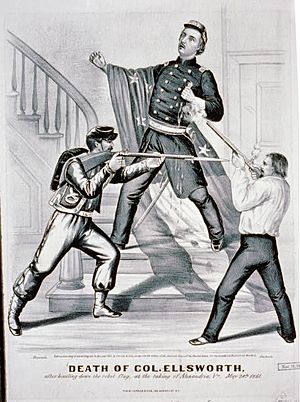Elmer E. Ellsworth facts for kids
Quick facts for kids
Elmer Ephraim Ellsworth
|
|
|---|---|
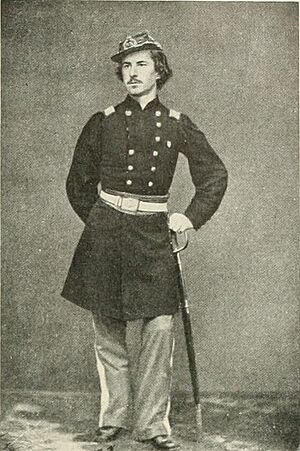
Col. Elmer Ellsworth in 1861
|
|
| Born | April 11, 1837 Malta, New York, U.S. |
| Died | May 24, 1861 (aged 24) Alexandria, Virginia, U.S. |
| Buried |
Hudson View Cemetery
Mechanicville, New York, U.S. |
| Allegiance | United States |
| Service/ |
United States Army |
| Years of service | 1861 |
| Rank | Colonel |
| Unit | 11th New York Volunteer Infantry Regiment |
| Battles/wars | American Civil War |
| Signature | |
Elmer Ephraim Ellsworth (born April 11, 1837 – died May 24, 1861) was an officer in the United States Army. He became the first important casualty and the first officer from the Union side to die in the American Civil War. He was killed while taking down a Confederate flag from a building in Alexandria, Virginia.
Before the war, Ellsworth led a famous military drill team called the "Zouave Cadets of Chicago". He was a close friend of Abraham Lincoln, who later became president. After Ellsworth's death, his body was honored at the White House. The words "Remember Ellsworth" became a strong rallying cry for the Union Army soldiers.
Contents
Early Life and Connections
Ellsworth was born as Ephraim Elmer Ellsworth in Malta, New York. He grew up in Mechanicville, New York, and later lived in New York City. In 1854, he moved to Rockford, Illinois, where he worked for a company that helped people get patents. In 1859, he got engaged to Carrie Spafford.
He later moved to Chicago to study law and work as a law clerk. In 1860, Ellsworth moved to Springfield, Illinois, to work with Abraham Lincoln. He studied law with Lincoln and helped with Lincoln's presidential campaign. Ellsworth then traveled with the new president to Washington, D.C.. Lincoln, who was very tall, called the shorter Ellsworth "the greatest little man I ever met."
Military Career and Zouaves
In 1857, Ellsworth became a drillmaster for a local militia group called the "Rockford Greys." He spent his free time studying military science. After successfully training the Greys, he helped other militia groups in Milwaukee and Madison. When he moved to Chicago, he became a Colonel of the "National Guard Cadets."
Ellsworth had studied the Zouave soldiers, who were French colonial troops in Algeria. He was very impressed by their fighting skills. He dressed his own men in Zouave-style uniforms and copied their unique drills and training methods. Ellsworth's unit became a nationally known drill team because of their impressive performances.
After Fort Sumter fell to Confederate forces in April 1861, President Lincoln asked for 75,000 volunteers. Ellsworth quickly formed the 11th New York Volunteer Infantry Regiment. This regiment, known as the "Fire Zouaves," was made up of volunteer firefighters from New York City. Ellsworth was then made the commanding officer of this new regiment.
The Death of Colonel Ellsworth
Ellsworth was killed on May 24, 1861, the day after Virginia officially left the Union. This happened during the Union Army's takeover of Alexandria. For a month before this, the owner of the Marshall House inn, James W. Jackson, had flown a large Confederate flag from his roof. President Lincoln and his team could even see this flag from Washington, D.C. Jackson had reportedly said that the flag would only be taken down "over his dead body."
Before crossing the Potomac River to enter Alexandria, Ellsworth's soldiers saw the flag through binoculars. They volunteered to remove it. After landing in Alexandria, Ellsworth and seven other soldiers went into the inn. Inside, they met a man whom Ellsworth asked about the flag. The man seemed scared and said he knew nothing about it.
Ellsworth then went upstairs, followed by his soldiers. He climbed a ladder to the roof and cut down the flag with a soldier's knife. As they came down, Private Francis E. Brownell was first, with Ellsworth behind him holding the flag. As Brownell reached the first landing, Jackson suddenly appeared from a dark hallway. He aimed a double-barreled shotgun at Ellsworth's chest and fired, killing him instantly.
Jackson then fired the other barrel at Brownell, but missed. Brownell's gun fired at the same time, hitting Jackson in the face. Before Jackson fell, Brownell repeatedly stabbed him with his bayonet. Jackson's body then fell down the stairs.
Ellsworth became the first Union officer to die in the Civil War. Brownell, who kept a piece of the flag, later received a Medal of Honor for his brave actions.
A Nation Mourns
Lincoln was very sad about his friend's death. He ordered an honor guard to bring Ellsworth's body to the White House. There, Ellsworth's body lay in state in the East Room for people to pay their respects. His body was then taken to the City Hall in New York City. Thousands of Union supporters came to see the first man to die for the Union cause. Ellsworth was later buried in his hometown of Mechanicville, New York.
Thousands of Union supporters were inspired by Ellsworth's death and joined the army. "Remember Ellsworth" became a popular patriotic saying. The 44th New York Volunteer Infantry Regiment even called themselves the "Ellsworth Avengers."
At the same time, Jackson became a hero for the Confederate side. A plaque honoring Jackson was placed near the site of the Marshall House. However, this plaque was removed in 2017.
Ellsworth's Legacy
After the Marshall House event, soldiers and souvenir collectors took pieces of the flag and the inn. They especially wanted parts of the stairway and floor coverings. Items connected to Ellsworth's death became valuable souvenirs.
President Lincoln kept the captured Marshall House flag. His son, Tad Lincoln, often played with it. The flag later went to Private Brownell. After Brownell died in 1894, his widow offered to sell small pieces of the flag.
Today, most of the flag is at the New York State Military Museum in Saratoga Springs. The museum also has Ellsworth's uniform, which has a bullet hole. Another small piece of the flag is at the Smithsonian Institution's National Museum of American History. This museum also has a blood-stained piece of floor covering from the Marshall House.
Other pieces of the flag are held by Bates College and the Fort Ward Museum in Alexandria. The Fort Ward Museum also displays the kepi (a military cap) Ellsworth wore when he was killed.
Several places were named in Ellsworth's honor. These include Ellsworth, Wisconsin, which became a new county seat. Other places like Ellsworth, Michigan, and Ellsworth, Iowa may also be named after him. There is also a Fort Ellsworth in Washington, D.C., and a street in Bronx, New York, called Ellsworth Avenue.
A song titled "Brave Men, Behold Your Fallen Chief" was written about him. He is also a character in the 2012 film Saving Lincoln. In 2021, a full book about his life was published, called First Fallen: The Life of Colonel Elmer Ellsworth, the North’s First Civil War Hero.
See also
Images for kids
-
The grave of Elmer E. Ellsworth, located in Hudson View Cemetery, Mechanicville, NY


